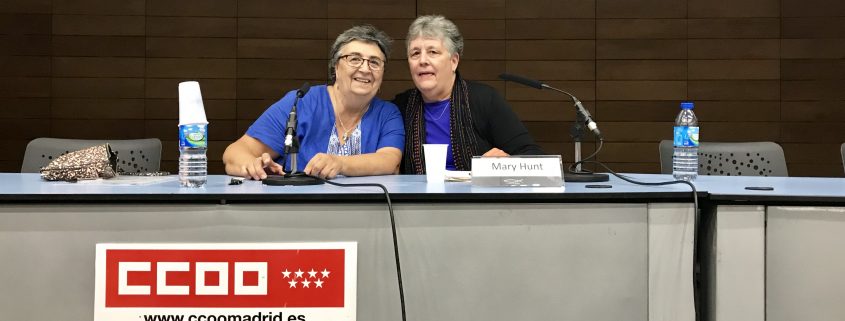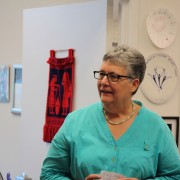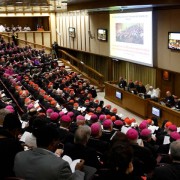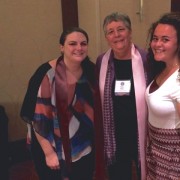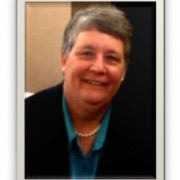The Power of Silence in the Work of Justice
The Power of Silence in the Work of Justice
Mary E. Hunt
September 8, 2018
Madrid, Spain
Please join me in two minutes of communal silence. Thank you.
Good afternoon. I am delighted to be with you finally for this conference. My deep thanks go to Juan Jose Tomayo and to Margarita Pintos for inviting me and arranging a delightful time in Madrid. I was honored to be invited in several past years, but a longstanding commitment to a women’s conference every year on this date prevented me from saying yes. I am grateful to be here now. I apologize for my mistakes in Spanish, but I know bad Spanish is preferable to perfect English.
I have learned a lot already this weekend about the many ways in which spirituality and justice work overlap. My contribution is to look at “The Power of Silence in the Work of Justice.” This appreciation of contemplation is an essential element of making social change. I do so from a feminist perspective grounded in the Catholic tradition and deeply indebted to other forms of spirituality.
I begin with my context; namely, the United States progressive community. Then, I will talk about the importance of meditation/contemplation in broad social terms, offer contemporary examples of how it works, and conclude with the role of contemplative prayer in sustaining energies.
Context:
I come to you from the United States where we are embroiled in a scandalous and dangerous political situation. It is made worse by underlying greed, discrimination, xenophobia, and disregard for the environment. The end of the Trump Administration cannot come soon enough for the good of the world.
Meanwhile, I, like many Americans, oppose the “Make America Great Again” policies with every fiber of our beings. The upcoming elections are crucial to changing the disastrous course that we are on. Wealthy and powerful people gain exponentially more while adult immigrants to a country of immigrants are torn from their children and poor citizens are deprived of the health care, education, and jobs they deserve. The hardest thing for me is knowing that a large percentage of the population, enough to elect him agrees with Trump’s ways. Changing those attitudes is crucial to making social change. So meditation, which some believe can actually transform energy fields, is a welcome tool though by no means a substitute for the hard work of organizing, lobbying, registering voters, and the rest necessary to stem the tide.
I also come from the progressive end of the religious spectrum rooted in the Catholic tradition. As a feminist, I have long rejected what Elisabeth Schüssler Fiorenza so helpfully defined as the ‘kyriarchal’ church. ‘Kyriarchy’ is the inter-structured forms of oppression that create the conditions for injustice. The institutional Catholic Church is one that literally ‘lords’ clergy over laity, men over women, religious over secular. Feminists in religion have ascribed to this analysis for decades, creating bountiful research and resources for overcoming it.
The rest of the world is now catching up with us as the Catholic institution stands in global disrepute and soon in financial ruin. Recent reports of Catholic clergy criminal conduct and its cover-up by church officials at the highest levels signal an end of the Roman Catholic Church as we knew it in the United States and perhaps in the rest of the world.
Catholics are 20% of the U.S. population, 51 million adults in the U.S. today, roughly 3 million fewer than in 2007. The percentage of Catholics who attend weekly mass dropped by 6% from 2014 to 2017 with current figures well under 40%. We are very similar to many European countries like Spain and formerly Catholic Ireland.
U.S. Catholics are disgusted and demoralized by a recent grand jury report (http://apps.washingtonpost.com/g/page/local/report-on-pennsylvania-church-sex-abuse/2319/) that documented over 1,000 children raped and abused by over 300 priests in just one state with 49 more states where similar investigations need to be done. There is every assurance from legal officials that the real numbers of victims/survivors are many times higher than reported. The report revealed that bishops routinely reassigned criminal clergy rather than prohibit them from ministry. This is a national problem as priests are moved around as if on a giant chessboard from parish to parish within a diocese or from diocese to diocese across the country.
In the case of Theodore McCarrick, Cardinal Archbishop of Washington, DC, the public learned that some bishops are offenders. McCarrick is credibly accused not only of pedophilia, but also of sexual acts with persons in his employ, namely seminarians and priests. While such workplace violations are not always criminal under U.S. law, they are always unethical. It seems that sex with the boss was important for advancement in the clerical system. This casts doubts on all of the higher-level clergy. Did they get their jobs because of competence or because of compliance in a despicable system?
Perhaps the most difficult matter in the case of McCarrick has been the response from those in the clergy that “everyone knew.” If “everyone knew,” how did he get to become a cardinal, the head of one of the most prestigious dioceses, trusted by the pope, and a key spokesperson against clergy sexual abuse? Accusations by Archbishop Carlo Maria Viganò, the former Apostolic Nuncio to the U.S., that even Pope Francis was aware that an earlier pope had sanctioned McCarrick, add another layer of deceit to this whole disgusting scene.
Obviously systematic lying and duplicity characterize “business of usual” in the Catholic institutional church. This is the norm in a structure that gives disproportionate power to the clergy over laity. It is a sick culture of repressed and misinformed sexuality, a case of kyriarchy write large.
For these reasons and others, I believe that the Catholic institution has run its course. But the challenges of daily life—a child gets sick, a parent dies, one loses one’s job, a relationship ends—continue and people need pastoral and spiritual resources for dealing with them. Millions of people who used to be Catholic will look elsewhere in their quest to be religious.
Of course some will leave religion aside entirely, an understandable choice. But because so much social justice work is fueled by religiously grounded ethics, I worry where the motivation will come from for people to stay engaged. I think it is important to maintain the contours of inter-religiously constructed values. Some of us bring Christian, Catholic liberationist content.
Feminists have known this problem for decades—the very religious tradition that gave us our deepest values was completely unreliable in institutional form. While Jesus might still have some appeal, the institutional repels us. A goal of the Women-Church Convergence, for example, has not been to reform or restructure the church but to let the needs of the world not the failings of the church set our agenda.
I think this is common in the postmodern world where the religious concerns of the past have been replaced by the moral issues of the future. If that is true, then our audience is much larger than we imagine. It is ironic at a time when a major religious institution is in collapse and much of its teachings and practices are greeted with skepticism and outright rejection, that it is the liberation theologians and our colleagues who are still standing! I have long predicted that we who were seen as heretics by popes and cardinals are more likely to be judged by history as apologists for Gospel values.
Decades of work by Catholic groups like Dignity, Women-Church Convergence, intentional Eucharistic communities, and many of the groups sponsoring this gathering to live out a faith that does justice pave the way for new models in a postmodern age. But the question for many people is where to start.
I propose that contemplative silence is a good starting point. Listening to the deep stirrings of the universe will not give all the answers. But contemplative silence will provide time for Spirit to emerge amid the din of injustice.
The worst possible outcome of the U.S. political debacle would be to forget our history as an experiment in democracy and a haven for those fleeing persecution. Likewise, the worst outcome of the demise of the Catholic institution would be for people to leave aside the tradition’s powerful message of love and justice, to confuse those grounding concepts with an institution that has proved itself to be incapable of carrying the freight of the Gospel. Silence makes room for all of that to emerge.
Title:
The title of my lecture, “The Power of Silence in the Work of Justice” is inspired by the great feminist ethicist Beverly Wildung Harrison. She published Our Right To Choose: Toward a New Ethic of Abortion in 1984, which remains the definitive Christian feminist treatment of that issue.[i] My title is a riff on the lecture/article she gave entitled “The Power of Anger in the Work of Love,” [ii] As a longtime Presbyterian social justice advocate especially for women, she wrote, “My theological method is consonant with those other liberation theologies that contend that what is authentic in the history of faith arises only out of the crucible of human struggle… we must learn what we are to know of love from immersion in the struggle for justice.” (p. 8) “Anger is not the opposite of love. It is better understood as a feeling-signal that all is not well in our relation to other persons or groups or to the world around us. Anger is a mode of connectedness to others and it is always a vivid form of caring…Where anger rises, there the energy to act is present” (p. 14).
In a parallel way, I claim silence is not the opposite of action or words. Rather, to enter into silence is to enter more deeply, undefended into the realities of the world. It is not to cut off oneself from the world’s struggles, but to embrace them at the most profound level even when the embrace occasions despair, even when human solutions appear impossible.
Silence is not for the timid. It is not an ally of inaction. Silence is a source of power, insight, and perspective. Silence fine-tunes and enhances insights; it helps to make Spirit and not Ego primary. Silence is not easy. But it is essential to the process of doing justice insofar as it provides the justice seeker with a trustworthy anchor, some protection in the very choppy waters of daily life.
Twelfth century mystic philosopher Hildegard of Bingen put it this way, “It is not far from the shores of silence to the boundaries of speech. The path is not long, but the way is deep. You must not only walk there, you must be prepared to leap.”[iii] With Hildegard, I affirm this intimate connection between silence and speech and urge us to leap together.
Let us take another two minutes to leap into communal silence before I continue. Thank you.
- The importance of meditation/contemplation in broad social terms
It is fascinating to observe that as Christian hegemony loses ground in the West, the longings of the human spirit for meaning and value, for connection and community, for justice and peace grow. So it is not surprising to see the wonderful proliferation of many forms of contemplative practice—from Buddhist forms of sitting to yoga, including hot yoga that is quite popular. It is common for young people to include some form of these practices in their regular routines, not necessarily ascribing any religious value to them, but understanding the general health and wellness involved. After all, meditation is alleged to be helpful for control of blood pressure, reduction of stress, and for basic personal integration and balance.
None of this is trivial for those who work on social change. We know the stresses of opposing dictators, autocrats, racists, and even church hierarchs. Still, I am deeply skeptical of the commercialization of spirituality. I find it pernicious that unscrupulous purveyors of spiritual fixes will sell virtually anything to people who seek meaning and value. I think people who are searching are particularly susceptible to such hucksters. Silence is not for sale.
What is widely available is enduring religious wisdom about contemplation that leads me to define it as “the deepest part of me touching into the deepest part of creation, and the deepest part of creation touching into the deepest part of me.” I learn from Hindus and Buddhists, not to mention early Christian contemplatives from the Desert Fathers to Mechtild of Magdeburg, Julian of Norwich, and Hildegard on Bingen. In light of our planetary ecological emergency, mine is a practical approach that reflects so many other religious efforts and refracts like a prism the concrete, purposeful reason to join our energies in communal contemplation with the reasonable expectation that it will change things.
- Contemporary examples
As a feminist social justice advocate busy with the injustices of church and state, I must say for all of my work as a liberation theologian I almost always gave liturgy, ritual, and prayer last place. But about twenty years ago, I spent several weeks living in a yurt high in the mountains in New Mexico as part of a retreat for social activists aimed at preventing us from burning out. It was an immersion into silence and Buddhist meditation that proved very helpful to wean me away from a well developed cynicism bred of too close an association with things Catholic.
One can get jaded in one’s own tradition and lose its richness. It would not have occurred to me to go to a Jesuit retreat for 30 days of silence and reflection on Christian scripture. But I was enthralled by the Buddhist approach. By the end of my time in the mountains, I was less critical of my tradition of origin, realizing that some people get from it what I do not for reasons of theo-politics: it is hard to pray with people who act as if you are not worthy. But I could see the connections down deep where we all live. I realized that how we get there, how we find our way to connectedness is less important than what we do out of the depths of commonness.
A few years later, my friend Nancy Sylvester, a member of the Sisters, Servants of the Immaculate Heart of Mary, gave the Presidential address to the Leadership Conference of Women Religious entitled “Risk the Scared Journey” (Aug. 18, 2000). [iv] She sketched out the many unfair and disagreeable encounters American nuns had had with the Vatican over recent decades and how the nuns tried, albeit largely unsuccessfully, to deal with them. She stated: “I believe we are at an impasse and that nothing less than contemplation which touches into our deepest core and stirs our God-given creativity will help us to imagine new ways of responding in love. And, that we must do individually and together.”
Nancy had come to her position of leadership in her own religious community after years as a lobbyist and later as the director of NETWORK Lobby for Catholic Social Justice founded in 1971 by progressive Catholic sisters. They are best known now as the “Nuns on the Bus” who continue the work of their insightful founders to bring Catholic social teaching to bear in U.S. government policies. Economic justice, anti-racism, and the like are on their agenda. As the Reagan years gave way to the Bush Presidencies, Nancy and many others felt at a similar impasse on social issues as she later came to feel in the church.
She began to offer workshops and teach people the rudiments of contemplative practice as rooted in the work of social change. In the same presidential address, she spelled out her experience with which I think many of us can resonate. She quoted another Catholic woman, Constance Fitzgerald, OCD, who “describes the signs of impasse. [v] These include: “a breakdown of communication; the inability to right a situation despite good and well-intentioned efforts; the dwindling of hope; the rise of disillusionment; and an obsession with the problem.”
Nancy went on to describe Constance’s view of “the spiritual significance of these ‘no way out’ experiences and how the Holy Spirit educates and transforms us through what she calls these inescapable and uninvited impasse experiences.” Nancy said, “Within this interpretative framework, what looks and feels like disintegration and meaninglessness is, at a more profound but hidden level of faith, a process of purification leading to a resurrection experience. To embrace the impasse or dark night is to free the Spirit to push us in the direction of intuition, imagination, contemplative reflection and ongoing discernment.” [vi] I trust Nancy’s perceptions that come from long years in social struggles.
Nancy Sylvester founded the Institute for Communal Contemplation and Dialogue in 2002. Now fifteen years into the work, she writes, “It is out of that place of fullness that I believe we must move forward. Contemplation invites a transformation of consciousness which in turn transforms how we live and act. The world is hungry for a new way of being that reflects more profoundly Gospel values.”[vii]
When I first started attending Nancy Sylvester’s weekends called “Engaging Impasse,” I was one of the few participants who were not nuns. I sometimes felt like an amateur at prayer as I often so when I join in prayer with communities of women religious, Buddhist practitioners, or devout Jews. They seem to know just how to do it while I flail and flounder spiritually right next to them. Do they see my inadequacy? How I flatter myself that they pay any attention to me, when in fact the only thing of importance in contemplation is that each one take her/his path.
Buddhists talk about the monkey mind—that constant chatter between our ears that has us sometimes writing our grocery lists and thinking about what we will cook for dinner when we are supposed to be engaged in meditation. Some Buddhists will say that it is not my fault, but the monkey mind of the person next to me. Indeed the monkey mind is all around, and the calm, centered, and collected person next to you works hard to focus as well.
Nancy cites scientific evidence and changing cosmologies to claim that communal contemplation can change consciousness. Nothing less than that change, she says, will be adequate in light of the ecological emergency. I hope she is right.
WATER, The Women’s Alliance for Theology, Ethics, and Ritual where I work, offers monthly meditation both for people who come to the office and for those who call in by phone. I laughed at first at the notion of people meditating by phone—conjuring vivid images of New Yorker cartoons and people oooohming into their handsets. How wrong I was!
It turns out to be a wonderful way to meditate together across the country. Someone offers five to ten minutes of input, we sit together for twenty-two minutes of silence, and then we reflect together on what we have gleaned. For example, I offered a meditation on one blueberry; we each ate one and savored it while reflecting on it as a springboard for our contemplation. Another time someone offered a blank canvas on which we were invited to sketch our dreams. We audiotape these events so you can go to our web site and listen as a spark for your own meditation.
The people who engage in this practice come from a wide range of starting points. Interestingly, Nancy invited equal numbers of men and men religious to her initial gatherings. Dozens of women signed up for three weekends of practice, but none of the invited men committed to spending the time together to learn.
WATER’s groups are open and welcoming; several men have come, but most are women who are deeply engaged in social justice work. One regular who has passed on was a nonagenarian nun who was a nurse, lactation specialist, and social justice advocate for her community. Another is a retired teacher who spends her days volunteering in a local food pantry and driving immigrants to their mandatory court appearances.
Our young interns are enthusiastic participants. They are recent college graduates giving a year of service before they embark on further study and career training. I am always amazed by how they prioritize contemplation in their busy schedules, valuing the new practice they learn and the intergenerational conversations and relationships that ensue around our circle. One of our phone regulars is a retired woman minister who lives on a farm in Ohio. Another is a committed activist poet from Boston; a third is a hospital chaplain from New York City. We share the leadership: one person volunteers to provide input each month. There is no leader of the group though we at WATER are the conveners.
These feminist forms of engaging in meditation stand in stark contrast to what I reject in the patriarchal tradition—the retreat master, the guru, the director—all of whom are in positions of power. Of course we have different experiences, but in meditation a young person’s fresh insights are as welcome as an elder’s wisdom.
I note a real change in our tone and intensity of conversation in the time after our meditation. We are all quite relaxed and focused. Inevitably we return to the pressing injustices of our day—we are in Washington, DC after all, an epicenter of misused power. But the quality of our conversation after meditation is different than before—more nuanced, less frantic, more open to seeing a variety of ways forward.
It is interesting that this approach of “Engaging Impasse” came from the deep frustration of nuns with their relations with the Vatican. In hindsight, the women were ahead of the rest of the church in calling out the injustices of what we now know as deep rot in the fabric of the Vatican.
When the Vatican launched its Apostolic Visitation of U.S. women’s active religious communities (2008-2014) [viii] and its Doctrinal Assessment of the Leadership Conference of Women Religious (2012-2014)[ix] the women reported that they found contemplative prayer a powerful resource for dealing with the colossal power difference between them and the men who were their accusers. Rather than create quiescence or encourage retreat in the midst of a serious struggle, the practice fortified them both individually and as communities (also across communities) for speaking their truth to the power that was oppressing them.
Ironically, the results of the two investigations were mixed—the Vatican still implying its insidious view that women are not capable of determining their own lives though admitting the many strong contributions of the women to church and world. But the sisters agreed that the biggest take away was their increased clarity about their own rights and responsibilities, their unity as women religious, and their resolve to live out their commitments to justice and peace. That is more than anyone might have hoped for going into the situation. I am tempted to say that the clerics escaped with their lives and their anatomy thanks to the women’s contemplative prayer! More importantly, as the implosion of the institutional church unfolds before our eyes, the women were surely right both in their strategies and tactics.
- The role of contemplative prayer in sustaining energies
I am convinced that contemplation done communally ‘works’ insofar as it quiets the mind, creates space for imagination, and connects us to something beyond ourselves. However, there is little encouragement for contemplation in most efforts to do justice with which I am engaged. We usually go bustling about quite sure that our efforts will make or break the situation, pausing rarely to ponder just what it is that we hope to accomplish or what is happening to us on the way.
I have experimented with contemplative silence in teaching and in other lecture situations with positive outcomes. Students tell me that they feel more disposed to listen, and colleagues report that the very act of taking the time to meditate together says something about our shared humanity, especially over the wide spectrum of differences that we live.
There are new efforts to teach meditation techniques to children in school. There is not good data about how useful it is, but I can imagine it calms them and helps they deal with stress. Amazingly, some schools are using meditation instead of detention to deal with behavioral problems.[x] Stretching and yoga can help them regain their composure and readiness to learn. I was not surprised to learn that the Thai boys were rescued from the cave where they got stuck were taught to meditate and it was thought to be part of what got them through their ordeal.[xi] So it might save us too as we spend our lives trying to bring about justice.
Still, I am not sure about two important factors. The first is that silence, prayer, contemplation can, if misused, be a trap especially for women and others who have been marginalized. There is a risk that people will be domesticated into silence, distracted from the hard issues of war, economic injustice, ecological disaster, sexist and racist violence, homohatred that kills. Why tell people who have been silenced by unjust structures to enter even more deeply into what could be their own oppression? We need to discuss this to avoid it.
The second thing that worries me about the role of silence in the work of social justice is the fact that the very people who most need to be silent are not. To the contrary, I have never seen in church or state those in power demonstrating their commitment to contemplation as a way of engaging the impasses they create. So there can be a certain naiveté in the process that must be guarded against.
Those and other uncertainties notwithstanding, when I think about the struggles in which we are engaged—immigrants and refugees throughout the world, nuclear impasse on the Korean Peninsula, economic gaps that increase by the hour, violence and abuse against women and people of color, the abject abandonment of children, and so many that you can name here in Spain—it is a litany that brings tears to the eyes. But one way of bringing our collective energies to bear on the transformation of our dear, beleaguered world, may be to close our eyes for a few minutes, only to open them again and see more clearly and concretely how we need to work together as never before.
Or so I hope.
Let us conclude with two more minutes of precious silence together.
Thank you.
NOTES
[i] Beverly Wildung Harrison, Our Right to Choose: Toward a New Ethic of Abortion. Boston: Beacon Press, 1984.
[ii] Beverly Wilding Harrison, “The Power of Anger in the Work of Love,” Union Seminary Quarterly Review, vol. xxxvi, Supplementary, 1981, pp. 41-57. It is also in Making the Connections; Essays in Feminist Social Ethics, edited by Carol S. Robb, Boston: Beacon Press, 1985, pp. 3-21.
[iii] Hildegard Von Bingen, Hildegard of Bingen, Scivias. Translated by Mother Columbia Hart and Jane Bishop, Mahwah, NJ: Paulist Press, 1990, page unknown.
[iv] Nancy Sylvester, http://www.iccdinstitute.org/home/risk-the-sacred-journey-presidential-address/.
[v] For more on “Impasse and Dark Night,” see Constance Fitzgerald, “From Impasse To Prophetic Hope: Crisis of Memory” file:///Users/mhunt/Downloads/4923-9232-1-SM%20(1).pdf. CTSA PROCEEDINGS 64 (2009): 21-42.
[vi] http://www.iccdinstitute.org/home/risk-the-sacred-journey-presidential-address/
[viii] For information on the Apostolic Visitation see, Power of Sisterhood: Women Religious Tell the Story of the Apostolic Visitation, edited by Margaret Cain McCarthy and Mary Ann Zollmann, Lanham, MD: UPA, 2014.
[ix] For information on the Doctrinal Assessment see, However Long the Night: Making Meaning in a Time of Crisis, A Spiritual Journey of the Leadership Conference of Women Religious (LCWR), edited by Annmarie Sanders, Silver Spring, MD, LCWR, 2018.
[x] https://www.cnn.com/2016/11/04/health/meditation-in-schools-baltimore/index.html
[xi] https://www.businessinsider.com/thai-cave-rescue-meditation-helped-keep-boys-alive-2018-7

